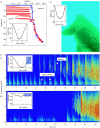Ascent exhalations of Antarctic fur seals: a behavioural adaptation for breath-hold diving?
- PMID: 15734689
- PMCID: PMC1634983
- DOI: 10.1098/rspb.2004.2964
Ascent exhalations of Antarctic fur seals: a behavioural adaptation for breath-hold diving?
Abstract
Novel observations collected from video, acoustic and conductivity sensors showed that Antarctic fur seals consistently exhale during the last 50-85% of ascent from all dives (10-160 m, n > 8000 dives from 50 seals). The depth of initial bubble emission was best predicted by maximum dive depth, suggesting an underlying physical mechanism. Bubble sound intensity recorded from one seal followed predictions of a simple model based on venting expanding lung air with decreasing pressure. Comparison of air release between dives, together with lack of variation in intensity of thrusting movement during initial descent regardless of ultimate dive depth, suggested that inhaled diving lung volume was constant for all dives. The thrusting intensity in the final phase of ascent was greater for dives in which ascent exhalation began at a greater depth, suggesting an energetic cost to this behaviour, probably as a result of loss of buoyancy from reduced lung volume. These results suggest that fur seals descend with full lung air stores, and thus face the physiological consequences of pressure at depth. We suggest that these regular and predictable ascent exhalations could function to reduce the potential for a precipitous drop in blood oxygen that would result in shallow-water blackout.
Figures




Similar articles
-
Fur seals do, but sea lions don't - cross taxa insights into exhalation during ascent from dives.Philos Trans R Soc Lond B Biol Sci. 2021 Aug 2;376(1830):20200219. doi: 10.1098/rstb.2020.0219. Epub 2021 Jun 14. Philos Trans R Soc Lond B Biol Sci. 2021. PMID: 34121462 Free PMC article.
-
The metabolic characteristics of the locomotory muscles of grey seals (Halichoerus grypus), harbour seals (Phoca vitulina) and Antarctic fur seals (Arctocephalus gazella).J Exp Biol. 1994 Sep;194:33-46. doi: 10.1242/jeb.194.1.33. J Exp Biol. 1994. PMID: 7964404
-
Skin temperatures during free-ranging swimming and diving in antarctic fur seals.J Exp Biol. 2000 Jun;203(Pt 12):1907-14. doi: 10.1242/jeb.203.12.1907. J Exp Biol. 2000. PMID: 10821747
-
Breath-Hold Diving.Compr Physiol. 2018 Mar 25;8(2):585-630. doi: 10.1002/cphy.c160008. Compr Physiol. 2018. PMID: 29687909 Review.
-
A review of the multi-level adaptations for maximizing aerobic dive duration in marine mammals: from biochemistry to behavior.J Comp Physiol B. 2014 Jan;184(1):23-53. doi: 10.1007/s00360-013-0782-z. Epub 2013 Oct 15. J Comp Physiol B. 2014. PMID: 24126963 Review.
Cited by
-
Terrestrial apnoeas and the development of cardiac control in Australian fur seal (Arctocephalus pusillus doriferus) pups.J Comp Physiol B. 2009 Apr;179(3):287-95. doi: 10.1007/s00360-008-0313-5. Epub 2008 Nov 5. J Comp Physiol B. 2009. PMID: 18985355
-
Fur seals do, but sea lions don't - cross taxa insights into exhalation during ascent from dives.Philos Trans R Soc Lond B Biol Sci. 2021 Aug 2;376(1830):20200219. doi: 10.1098/rstb.2020.0219. Epub 2021 Jun 14. Philos Trans R Soc Lond B Biol Sci. 2021. PMID: 34121462 Free PMC article.
-
Thermal and digestive constraints to foraging behaviour in marine mammals.Philos Trans R Soc Lond B Biol Sci. 2007 Nov 29;362(1487):2151-68. doi: 10.1098/rstb.2007.2108. Philos Trans R Soc Lond B Biol Sci. 2007. PMID: 17472918 Free PMC article.
-
First evidence of underwater vocalisations in hunting penguins.PeerJ. 2019 Dec 18;7:e8240. doi: 10.7717/peerj.8240. eCollection 2019. PeerJ. 2019. PMID: 31976165 Free PMC article.
-
Lung collapse in the diving sea lion: hold the nitrogen and save the oxygen.Biol Lett. 2012 Dec 23;8(6):1047-9. doi: 10.1098/rsbl.2012.0743. Epub 2012 Sep 19. Biol Lett. 2012. PMID: 22993241 Free PMC article.
References
-
- Biuw M., McConnell B.J., Bradshaw C.J.A., Burton H., Fedak M. Blubber and buoyancy: monitoring the body condition of free-ranging seals using simple dive char acteristics. J. Exp. Biol. 2003;206:3405–3423. - PubMed
-
- Boyd I.L., Croxall J.P. Diving behaviour of lactating Antarctic fur seals. Can. J. Zool. 1992;70:919–928.
-
- Boyd I.L., Reid K., Bevan R.M. Swimming speed and allocation of time during the dive cycle in Antarctic fur seals. Anim. Behav. 1995;50:769–784.
-
- Boyd I.L., Bevan R.M., Woakes A.J., Butler P.J. Heart rate and behavior of fur seals: implications for measurement of field energetics. Am. J. Physiol. 1999;276:H844–H857. - PubMed
-
- Boyd I.L., Staniland I.J., Martin A.R. Distribution of foraging by female Antarctic fur seals. Mar. Ecol. Prog. Ser. 2002;242:285–294.
Publication types
MeSH terms
Substances
LinkOut - more resources
Full Text Sources

